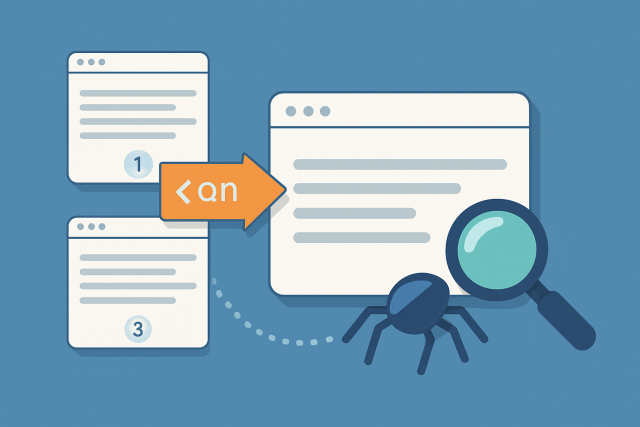
What is canonical pagination and why it matters for SEO?
Canonical pagination helps search engines identify the preferred page among multiple paginated URLs,...

Choosing between a 301 and a 302 redirect can often leave webmasters and SEO specialists scratching their heads. This decision plays a surprisingly big role in your website's search rankings and user experience.
| Feature | Redirect 301 | Redirect 302 |
|---|---|---|
| HTTP Status Code | 301 Moved Permanently | 302 Found (Temporary Redirect) |
| Permanence | This one’s a forever kind of redirect | More of a 'for now' redirect |
| SEO Link Equity | Passes along nearly all the SEO juice (PageRank) | Usually keeps that SEO juice close to the original |
| Caching Behavior | Browsers and search engines tend to hold on to this one | Usually doesn’t stick around in caches for long |
| Browser Handling | Automatically zips users over to the new URL | Redirects temporarily, expecting the original URL to stick around |
| Impact on Indexing | Search engines update their records to point to the new spot | The original URL usually stays in the search index |
| Common Usage | Perfect for site moves, changing URLs, or removing content | Great for A/B testing, short-term campaigns, or maintenance windows |
Redirect 301 is the go-to solution when you permanently move a URL or domain. It signals to search engines that the original page has packed its bags and moved out for good. This helps pass along SEO value, keep your rankings intact and ensure users land exactly where they’re supposed to.
A 302 redirect is your go-to move when you need to temporarily steer visitors toward a different URL without shaking up your current SEO mojo or throwing search engines for a loop. It gently tells them that the original URL should stick around in the index, while displaying a different page just for a little while
Redirect 301 is a real MVP in the SEO world, quietly passing almost all the link equity to the new URL and giving search engines a clear heads-up that the move is permanent. Redirect 302 plays it a bit differently—it keeps the original URL hanging around in the index and hands over only limited link equity.
| SEO Factor | Redirect 301 | Redirect 302 |
|---|---|---|
| PageRank Flow | Almost all the value smoothly passes to the new URL | Usually, no value passes along; the original URL holds onto its ranking like a stubborn mule |
| Indexing Behavior | Search engines swap out the old URL for the new one without fuss | The original URL tends to stick around indexed, refusing to bow out quietly |
| Traffic Retention | Maintains rankings and referral traffic pretty steadily | Effects are often short-lived, and traffic can dance up and down unpredictably |
| Crawl Budget Impact | Works like a charm by cutting down on unnecessary crawling trips | Might cause extra crawling if those redirects happen too frequently, which can be a bit annoying |
| Long-term SEO Impact | Generally positive and stable when handled right; a reliable friend | Can be neutral or even a bit of a troublemaker if left in place for too long |
Both 301 and 302 redirects add an extra HTTP request which can slow down page loading slightly. 301 redirects usually stay longer in browsers and CDNs' memory. This means when users return pages load faster like a well-oiled machine. Meanwhile, 302 redirects are marked as "temporary" so they are not cached much making repeat visits feel slower. Choosing the right redirect is not just about SEO but also boosts user experience by cutting down redirect delays. Tools like Moz Pro's Site Audit can find redirect chains and help smooth things out to keep your site running smoothly.
Many webmasters tend to treat 302 redirects like they’re permanent fixtures, which can quietly let your hard-earned SEO value slip through the cracks. Redirect chains and loops don’t just gum up the works—they can really slow down your site’s performance and leave search engines scratching their heads over your structure, ultimately hurting your rankings. On top of that, ignoring canonical tags or using redirects willy-nilly often sparks crawl errors and chips away at your site’s authority.
You can set up 301 and 302 redirects in a few ways like tweaking server configuration files such as the .htaccess for Apache or adjusting NGINX config blocks. You can even handle it straight in your application code using PHP headers. Plenty of CMS platforms including WordPress offer easy-to-use plugins that take the tech headache out of managing redirects. Testing those redirects thoroughly before going live is key.
.htaccess file using Redirect 301 /old-page https://example.com/new-page for permanent moves or switch to Redirect 302 if it’s just a temporary detourreturn 301 https://example.com/new-page or return 302 inside the server blockheader('HTTP/1.1 301 Moved Permanently') and header('Location: /new-page') to gracefully handle redirects behind the scenesSEO experts usually see pretty solid positive results when 301 redirects are used the right way during site migrations, often helping to keep organic rankings steady or sometimes even nudge them higher after the move. On the flip side, relying on 302 redirects for permanent moves tends to lead to noticeable drops in both traffic and rankings. Companies often find better user retention when 302 redirects are applied properly for temporary maintenance periods. Tools like Moz Pro and Mangools back up these observations with solid data from link analysis and rank tracking.
"Nailing the use of a 301 redirect can be a real game-changer for holding onto all that SEO juice you have worked hard to build, whereas messing up with a 302 redirect often ends up costing you rankings and traffic—more than you would expect. Getting a solid grip on the difference between these two is absolutely essential for any SEO strategy worth its salt." – Rand Fishkin, SEO Expert and Founder of Moz
12 articles published
Transforming the field of content marketing, Sylvia Lindqvist's expertise lies in crafting compelling narratives that resonate with target audiences and drive measurable results.
Read Pages
Canonical pagination helps search engines identify the preferred page among multiple paginated URLs,...

Discover essential SEO strategies tailored for single page applications to overcome unique challenge...

Discover how to optimize headless CMS SEO effectively with advanced rendering methods, metadata auto...

Soft 404 errors can harm your website’s SEO and user experience by confusing search engines and visi...